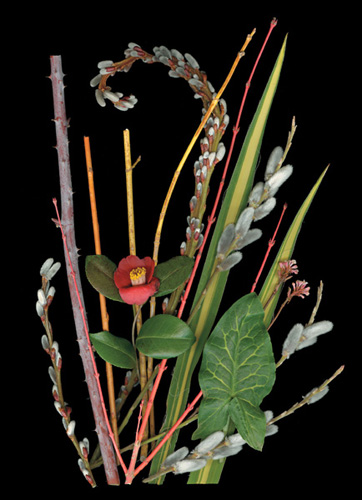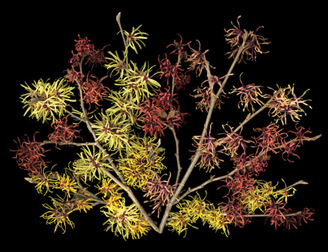
In the depth of winter in Zone 6, color comes from: A ghost bramble (Rubus thibetanus), silver coating has worn off; B Salix alba subsp. vitellina ‘Britzensis’; C yellow twig dogwood Cornus sericea ‘Silver and Gold’; D fishtail willow (Salix sachalinensis ‘Sekka’); E variegated evergreen Yucca filamentosa ‘Color Guard’; F early giant pussy willow (Salix chaenomeloides); G buds of Viburnum farreri; H leaf of Arum italicum; I coral-bark maple (Acer palmatum ‘Sango Kaku’); J common pussy willow Salix caprea; K early red Camellia japonica ‘Adeyaka’.

There are camellias that bloom in the late fall (C. sasanqua varieties) and many more that flower in winter (including C. japonica varieties). Shrub dogwoods and certain willows are grown for their winter twigs. These are pruned hard in late winter to force colorful new shoots. Cornus stolonifera ‘Flavarima’ has yellow twigs; C. alba ‘Argenteomarginata’ or ‘Elegantissima’ is a variegated selection with red twigs. C. sanguinea ‘Midwinter Fire’ displays apricot, coral, and orange on the same stems. Plant these so their south-facing sides—where the color is brightest—will be in view. Cut the three-year-old stems down to two inches.
Some of the colorful willows are red-orange Salix alba ‘Britzensis’, yellow to red ‘Chermesina’, and bright yellow ‘Vitellina’. Hybrid S. x ‘Flame’ is red and orange. S. fragilis ‘Belgian Red’ is almost maroon. S. purpurea ‘Eugenii’ has purple stems. These willows can be cut back nearly to the ground every year, which will result in growth that is, depending on variety, four to ten feet tall.
There are surprising evergreen subshrubs like the variegated yuccas for winter in all but the coldest climates. Other early blooming genera include wintersweet (Chimonanthus praecox), Cornelian cherry (Cornus mas), winterhazel (Corylopsis spp.), spring heath (Erica carnea), winter jasmine (Jasminum nudiflorum), winter honeysuckle (Lonicera fragrantissima), Stachyurus praecox, ‘Dawn’ Viburnum (Viburnum x bodnantense ‘Dawn’), and the most welcome winter shrubs—witch hazels with tiny ribbon flowers. Hamamelis vernalis, which grows naturally from Missouri down to Louisiana, blooms with yellow to orange fragrant flowers even before the vernal season—the source of its specific epithet. There are a few new H. vernalis with purple to reddish flowers, like the varieties ‘Amethyst’ and ‘Purpurea’. (H. virginiana is a hefty North American shrub with yellow flowers in fall.)
The winter witch hazel stars are often hybrids listed as Hamamelis x intermedia. Most are fragrant, either up close, cut and brought inside, or sampled on the breeze. ‘Rochester’ has the strongest perfume. Popular varieties include bright yellow and red ‘Arnold Promise’, clay red ‘Diane’, copper ‘Jelena’, bright yellow ‘Primavera’, and soft yellow, lightly-scented ‘Westerstede’.
The witch hazels want sun and moist soil, and for best effect, should be sited in front of evergreens and where the low rays of the winter sun can ignite the flowers. In leaf, these shrubs are somewhat coarse, and should be planted where they can recede into the background come summer. Some have good fall color.
Late winter witch hazel varieties of Hamamelis x intermedia (clockwise from bottom left): ‘Nina’, ‘Jelena’, ‘Arnold Promise’, ‘Sunburst’, ‘Diane’, ‘Strawberries and Cream’, ‘James Wells’.
